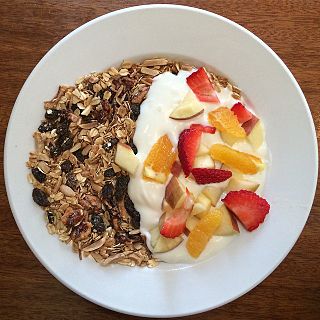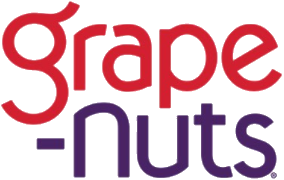Related Research Articles

Breakfast cereal is a traditional breakfast food made from processed cereal grains. It is traditionally eaten as part of breakfast, or a snack food, primarily in Western societies.

Corn flakes, or cornflakes, are a breakfast cereal made from toasting flakes of corn (maize). Originally invented as a breakfast food to counter indigestion, it has become a popular food item in the American diet.

Cornmeal is a meal ground from dried corn. It is a common staple food, and is ground to coarse, medium, and fine consistencies, but not as fine as wheat flour can be. In Mexico, very finely ground cornmeal is referred to as corn flour. When fine cornmeal is made from maize that has been soaked in an alkaline solution, e.g., limewater, it is called masa harina, which is used for making arepas, tamales and tortillas. Boiled cornmeal is called polenta in Italy and is also a traditional dish and bread substitute in Romania.

Muesli is a cold Swiss breakfast dish, the primary ingredient of which is rolled oats. Most often, it is set to soak overnight and eaten the next morning. Additional ingredients, such as grains, nuts, seeds, and fresh or dried fruits, are added, along with milk or cream, a squeeze of citrus juice, and honey to add sweetness. Yoghurt or other mammal or plant milk products are now commonly added to both homemade and commercially packaged muesli recipes.

Nutri-Grain is a brand of breakfast cereal and breakfast bar made by the Kellogg Company. In Australia and New Zealand Nutri-Grain is a breakfast cereal made from corn, oats, and wheat. The pieces are shaped like bricks.

Granola is a food consisting of rolled oats, nuts, seeds, honey or other sweeteners such as brown sugar, and sometimes puffed rice, that is usually baked until crisp, toasted and golden brown. The mixture is stirred while baking to avoid burning and to maintain a loose breakfast cereal consistency. Dried fruit, such as raisins and dates, and confections such as chocolate are sometimes added. Granola is often eaten in combination with yogurt, honey, fresh fruit, milk or other forms of cereal. It also serves as a topping for various pastries, desserts or ice cream. Muesli is similar to granola, except that it is traditionally neither sweetened nor baked.

Special K is an American brand of breakfast cereal and meal bars manufactured by Kellogg's. The cereal was introduced to the United States in 1955. It is made primarily from grains such as lightly toasted rice, wheat and barley. Special K used to be marketed primarily as a low-fat cereal that can be eaten to help one lose weight.
Post Consumer Brands is an American breakfast cereal manufacturer headquartered in Lakeville, Minnesota.

Grape-Nuts is a brand of breakfast cereal made from flour, salt and dried yeast, developed in 1897 by C. W. Post, a former patient and later competitor of the 19th-century breakfast food innovator Dr. John Harvey Kellogg. Post's original product was baked as a rigid sheet, then broken into pieces and run through a coffee grinder.

James Caleb Jackson was an American nutritionist and the inventor of the first dry, whole grain breakfast cereal which he called Granula. His views influenced the health reforms of Ellen G. White, a founder of the Seventh-day Adventist Church.

Chex is an American brand of breakfast cereal currently manufactured by General Mills. It was originally produced and owned by Ralston Purina of St. Louis, Missouri, using the name Chex starting in 1950. The Chex brand went with corporate spinoff Ralcorp in 1994. and was then sold to General Mills in 1997. Rival cereal company Kellogg's has the rights to the Chex brand in South Korea and Singapore.

Banitsa, also transliterated as banica and banitza, is a traditional pastry dish made in Bulgaria, North Macedonia and Southeastern Serbia, prepared by layering a mixture of whisked eggs, natural yogurt and pieces of white brined cheese between filo pastry and then baking it in an oven.

Honey Bunches of Oats is a breakfast cereal owned by Post Holdings and produced by its subsidiary Post Consumer Brands. Created by lifelong Post employee Vernon J. Herzing by mixing several of Post's cereals together and having his daughter taste them, Honey Bunches of Oats was introduced to markets in 1989 after three years of development. The cereal is made up of three kinds of flakes and oat clusters baked with a hint of honey. It is marketed as a source of whole grain. Other varieties have almonds or fruits added into the mix.

A Dutch baby pancake, sometimes called a German pancake, a Bismarck, a Dutch puff, or a Hootenanny, is a large American popover.

Puto is a Filipino steamed rice cake, traditionally made from slightly fermented rice dough (galapong). It is eaten as is or as an accompaniment to a number of savoury dishes. Puto is also an umbrella term for various kinds of indigenous steamed cakes, including those made without rice. It is a sub-type of kakanin.

A great variety of cassava-based dishes are consumed in the regions where cassava is cultivated, and the ingredient is included many national or ethnic specialities.

Sponge cake is a light cake made with egg whites, flour and sugar, sometimes leavened with baking powder. Some sponge cakes do not contain egg yolks, like angel food cake, but most of them do. Sponge cakes, leavened with beaten eggs, originated during the Renaissance, possibly in Spain. The sponge cake is thought to be one of the first of the non-yeasted cakes, and the earliest attested sponge cake recipe in English is found in a book by the English poet Gervase Markham, The English Huswife, Containing the Inward and Outward Virtues Which Ought to Be in a Complete Woman (1615). Still, the cake was much more like a cracker: thin and crispy. Sponge cakes became the cake recognized today when bakers started using beaten eggs as a rising agent in the mid-18th century. The Victorian creation of baking powder by English food manufacturer Alfred Bird in 1843 allowed the addition of butter to the traditional sponge recipe, resulting in the creation of the Victoria sponge. Cakes are available in millions of flavours and have many recipes as well. Sponge cakes have become snack cakes via the Twinkie.

Paximathia, also spelt paximadia (plural), or paximadi/paximathi (singular), is a hard bread of Greek origin, similar to rusk, that is prepared with whole wheat, chick pea or barley flour. It has been referred to as being similar to biscotti or as a type of biscotti. Paximathia is a common food in Greece and many Greek bakeries sell the bread, which is often served as a breakfast food with marmalade or cheese. Paximathia is purveyed also in Greek specialty stores in many areas of the United States.
References
- ↑ "Dansville History". Dansville Public Library. Archived from the original on 2014-03-31. Retrieved 2013-11-14.
- 1 2 "Granola History". The Nibble: Great Food Finds. The Magazine about Specialty Foods. Retrieved 2013-11-14.
- ↑ "The Early Days Of Breakfast Cereal". MrBreakfast.com. Retrieved 2013-11-14.
- ↑ Greenbaum start, Hilary; Dana Rubenstein (2012-03-23). "Who Made That Granola?". New York Times. Retrieved 2013-11-14.
- ↑ 1906 Recipe for Granula, Sister Amanda Witmore, McPherson, KS